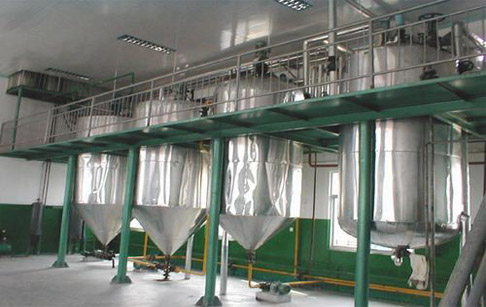Semi-continuous oil refining equipment is a new type of oil refining equipment with the characteristics of reliable performance, high degree of mechanization, and excellent process technology. It combines the advantages of intermittent oil refining technology and fully continuous oil refining technology. Semi-continuous oil refining is carried out in stages: the degumming section, deacidification section and decolorization section all adopt intermittent treatment methods to remove water-soluble colloids and water-insoluble colloids in crude oil, as well as FFA (free fatty acids) and other impurities in oil. Chlorophyll, carotene, flavonoid pigments, anthocyanins and certain sugars and protein decomposition products in oil will also be removed; the deacidification and deodorization process adopts a continuously produced deodorization tower to remove odorous substances and part of FFA in oil. Both intermittent and continuous production can be achieved in the same refining process.
Semi-continuous oil refining equipment can complete the process operations of hydration, alkali refining, water washing, decolorization and deodorization, and adopts advanced technologies such as electronic metering, high-speed centrifuge soap removal, vacuum (continuous) drying, etc., mainly used for pre- The rapeseed oil, cottonseed oil, peanut oil, linseed oil and other vegetable oils produced by the pressing-extraction and one-time extraction oil-making processes, as well as the refining of animal fats such as lard, tallow and sheep oil, are also suitable for rice bran oil, sunflower oil, etc.
Process flow of semi-continuous oil refining equipment:
The crude oil is pumped into the oil refining pot by a pump for degumming and neutralization operations. When the oil and soap are obviously separated and sink rapidly, stop stirring, let it stand, and then suck out the upper clear oil into the water washing tank. The soap feet are placed in the soap foot barrel from the bottom drain pipe. When the soap feet contain more oil, stop placing the soap feet, and the soap feet are pumped into the soap foot tank by the pump. The remaining oil in the oil refining tank is mixed into the tank to continue. The clear oil transferred from the oil refining tank is washed with water and then sent to the decolorization tank for adsorption decolorization.
The decolorized oil is pumped into the gas analyzer at a constant flow rate by a pump, and the oil flow rate is adjusted by a flow meter. In the gasifier, the oil is sprayed out through multiple nozzles on the feed pipe. The gasifier maintains a high vacuum of about 3mmHg to release the small amount of air that has penetrated into the oil. The oil comes out of the gasifier and is pumped into the oil-oil heat exchanger to exchange heat with the hot oil coming out of the deodorizing tower and is heated to at least 180℃. From the oil-oil heat exchanger, the oil flows into the thermal oil heater and is heated to 260℃. The thermal oil is heated to 290℃ in the thermal oil furnace and is recycled throughout the process. The hot oil to be deodorized enters the combined deodorizing tower from the thermal oil heater, and fatty acids and other relatively volatile odorous substances are extracted with direct steam in the packing section, and then enters the plate section for deodorization and thermal decolorization. When processing oil products with low acid value or low requirements for the acid value of finished oil, it can be directly deodorized and decolorized in the plate section without passing through the packing section. Deacidification and deodorization are operated under high temperature and 3mmHg pressure vacuum state, and the vacuum is generated and maintained by a four-stage vacuum pump system. The deacidified and deodorized oil is discharged from the combined deodorization tower, pumped into the heat exchanger for heat exchange with the oil to be deodorized, and then enters the cooler and is cooled by water. After cooling, the oil temperature is not higher than 70℃, and it is filtered through a fine filter for insurance filtration and then stored in the finished oil storage tank.
For oils with high fat (wax) content such as tea seed oil, rice bran oil, and corn germ oil after deodorization, further dewaxing and degreasing should be carried out.
(Related equipment:Batch oil refining equipment,Fully continuous oil refining equipment)
